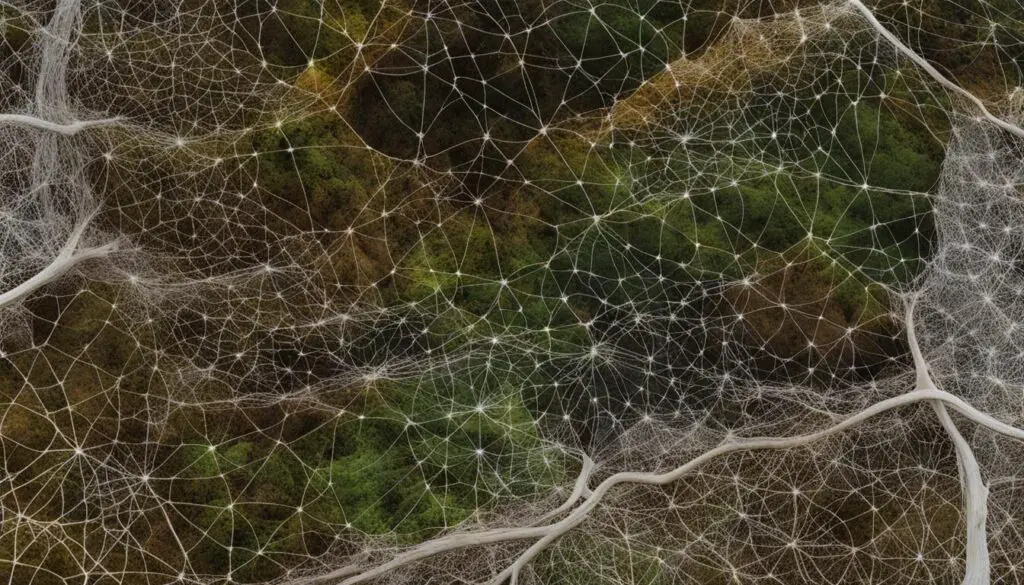Have you ever wondered if trees communicate with each other? The idea of trees talking may seem far-fetched, but scientific research has revealed fascinating insights into the communication systems of trees. It turns out that trees have their own language, a complex network that allows them to share resources and messages.
Key Takeaways:
- Trees have a sophisticated communication system through underground fungal networks.
- These networks enable trees to share water, nutrients, and information about danger or disease.
- Scientists have discovered that trees of the same species can form alliances and cooperate with each other.
- Peter Wohlleben and Suzanne Simard are renowned researchers who have advanced our understanding of tree communication.
- Tree communication plays a vital role in forest ecosystems and has implications for conservation and environmental management.
The Hidden Life of Trees: Peter Wohlleben’s Groundbreaking Research
Peter Wohlleben, a German forester and author, has gained international recognition for his book “The Hidden Life of Trees: What They Feel, How They Communicate.” In this fascinating work, Wohlleben delves into the intricate world of tree communication, revealing the remarkable interconnectedness and intelligence of these silent giants.
Wohlleben describes trees as social beings that form a superorganism, with each tree playing a unique role in the forest ecosystem. He refers to himself as a “tree whisperer” and shares his insights gained from years of experience working closely with trees in forests.
The Hidden Life of Trees explores how trees communicate, feed each other, and warn of danger. Wohlleben reveals that wise old mother trees help nurture and feed their saplings through an intricate network of roots and mycorrhizal fungi. These mother trees also communicate with neighboring trees, sending warning signals about impending threats such as pests or drought.
Wohlleben’s research has sparked a revolution in our understanding of tree communication, challenging the notion that trees are disconnected individuals solely competing for resources. Instead, it unveils a sophisticated network where trees support each other and form cooperative alliances.
“Every tree is valuable to the community, and the community is valuable to every tree.” – Peter Wohlleben
Through his work, Wohlleben has popularized the idea that trees are not just silent spectators in forests but are active participants in a complex web of life. He invites readers to see trees in a new light, not merely as a backdrop to our lives but as multifaceted organisms with a hidden world of communication and collaboration.
As we delve deeper into the hidden life of trees, we gain a greater appreciation for their importance in maintaining healthy ecosystems and the urgent need to protect and preserve the intricate communication networks that sustain them.
Suzanne Simard: Unlocking the Secrets of Tree Communication
Suzanne Simard, an ecologist at the University of British Columbia, has made significant contributions to our understanding of tree communication through her research in this field. Her work has shed light on the intriguing concept that trees are not solitary organisms but rather “social creatures” that rely on underground fungal networks to communicate.
In Simard’s groundbreaking research, she has discovered that trees use latticed fungi in the soil to establish connections between their root systems. These fungal networks serve as channels through which trees can exchange nutrients, water, and even warning signals about changes in their environment. By studying these intricate connections, Simard has unraveled the complex web of relationships that exists within forest ecosystems.
The underground fungal networks play a crucial role in facilitating tree communication. Through these networks, trees can share resources and support one another, leading to mutual benefits and increased resilience in the face of environmental challenges. Simard’s work has brought to light the vital role of these underground networks, highlighting their significance in fostering the interconnectedness and cooperation observed in forests.

Simard’s research has revolutionized our understanding of tree communication and has paved the way for new perspectives on the intelligence and social dynamics of trees. Her findings have far-reaching implications, not only for the scientific community but also for forest management and conservation efforts. By recognizing and preserving the essential role of underground fungal networks, we can better protect and nurture the health and diversity of forest ecosystems.
The Impact of Suzanne Simard’s Research:
| Key Discoveries | Implications |
|---|---|
| Tree communication through underground fungal networks | Understanding the interconnectedness and cooperation in forest ecosystems |
| Exchange of nutrients and warning signals among trees | Enhanced resilience and survival in the face of environmental changes |
| Recognition of trees as “social creatures” | Redefining our perception of tree intelligence and behavior |
| Promotion of sustainable forest management practices | Preserving the health and diversity of forest ecosystems |
The Language of Trees: Chemical, Electrical, and Acoustic Signaling
Trees, like humans and animals, have their own unique forms of communication. Through chemical, electrical, and even acoustic signals, trees are able to convey important messages to each other and respond to their environment.
One of the most common forms of tree signaling is through chemical signals. Trees release hormones and pheromones into the air or through their extensive underground networks of fungi, known as mycorrhizal networks. These chemical signals can serve multiple purposes, including alerting nearby trees to the presence of predators or pathogens, signaling distress or injury, and even attracting beneficial insects for pollination or defense.
Interestingly, trees also exhibit electrical signaling, similar to the nervous systems found in animals. Scientists have discovered that trees are capable of generating and transmitting electrical impulses, which can play a role in alarm and distress signaling. These electrical signals allow trees to quickly respond to threats and coordinate their defense mechanisms.
Furthermore, recent research suggests that trees may also communicate through acoustic signals. Trees have been found to emit sounds, including a crackling noise in their roots. While the exact purpose of these acoustic signals is still being studied, it is believed that they may provide a means of communication between trees, potentially conveying information about soil conditions, water availability, or even warning signals.
The diverse language of trees, consisting of chemical, electrical, and acoustic signals, allows them to effectively communicate and respond to their environment. Through these signaling mechanisms, trees are able to share information, coordinate defense strategies, and support the overall health of the forest ecosystem.
The Role of “Mother Trees” and Kin Recognition
Within a forest ecosystem, “mother trees” play a crucial role in facilitating tree communication and cooperation. These remarkably large and ancient trees nurture and provide support to their offspring and nearby seedlings, creating an interconnected web of relationships within the forest.
Through mycorrhizal networks, which are underground fungal networks, mother trees transmit vital nutrients, carbon, and even warning signals to their kin. This process aids in the survival and thriving of their offspring, ensuring the continuation of the species. Mother trees exhibit a heightened sense of kin recognition, enabling them to distinguish between their own offspring and unrelated individuals.
This kin recognition mechanism ensures preferential treatment and support for their own kin, displaying a remarkable cooperative behavior within the forest community. The advanced social structure and intelligence exhibited by trees through these interconnected relationships emphasize the significance of tree cooperation in maintaining a healthy and balanced ecosystem.

Cooperation and Collaboration Among Trees
The concept of mother trees and kin recognition indicates that trees are not solitary individuals competing for resources, but rather complex beings that work together to ensure the well-being of the entire forest community. This cooperative nature can be observed through various mechanisms, such as the sharing of resources, protection from threats, and even the provision of shade and shelter for neighboring trees.
“Trees in forests are social beings. They can cooperatively work against their predators. Wind-breaking by older trees in the forest crown is an example of their collaborative behavior.” – Peter Wohlleben
By collaborating and supporting each other, trees promote the overall resilience and longevity of the forest. This cooperation is essential for maintaining a healthy ecosystem, as trees are more resilient to environmental stressors and disturbances when they work together.
The Beauty of Tree Cooperation
The existence of mother trees and the recognition of kin relationships among trees offer a profound appreciation for the social and intelligent nature of these organisms. Trees demonstrate a sophisticated understanding of their surroundings, the needs of their offspring, and the importance of collaboration within their community.
Understanding and valuing the crucial role mother trees play in tree communication and cooperation can guide effective forest management and conservation practices. By protecting and preserving the habitats of mother trees and promoting the health of their offspring, we can contribute to the overall well-being of forest ecosystems.
The Impact of Environmental Threats on Tree Communication
Environmental threats pose significant challenges to tree communication and the delicate balance of forest ecosystems. Climate change, logging activities, and pine beetle infestations can disrupt the mycorrhizal networks that facilitate tree communication, leading to a breakdown in the exchange of nutrients and crucial messages between trees. This disruption can have far-reaching consequences for the health and resilience of forests.
Climate change, characterized by rising temperatures, increased frequency of extreme weather events, and altered rainfall patterns, poses a grave threat to tree communication. Drought conditions can weaken trees, making them more vulnerable to pests and diseases. Additionally, changes in temperature and precipitation can affect the composition of fungal networks, compromising their functionality and restricting the flow of resources and information between trees.
Logging activities, both legal and illegal, pose another major threat to tree communication. Deforestation and selective logging can disrupt the complex web of fungal networks that connect trees. With the loss of old-growth and mother trees, younger trees lose access to vital resources and the wisdom and protection offered by these key contributors to the forest ecosystem.
Pine beetle infestations, fueled by warmer temperatures and weakened tree defenses, have ravaged forests in many regions. These beetles disturb tree communication by infesting and killing trees, interrupting the exchange of signals and nutrients within the forest network. The death of trees and subsequent degradation of the fungal networks further exacerbate the impact of these infestations.
Understanding the effects of these environmental threats on tree communication is crucial for effective forest management and conservation efforts. It is imperative to develop strategies that mitigate the negative impact of climate change, promote sustainable logging practices, and combat pest infestations. By preserving and restoring healthy mycorrhizal networks, we can safeguard the communication systems that sustain and strengthen forest ecosystems.
The Fragile Connection: Environmental Threats vs. Tree Communication
| Environmental Threat | Effects on Tree Communication |
|---|---|
| Climate Change | Disrupts fungal networks, impairs resource sharing and information exchange between trees |
| Logging | Destroys mycorrhizal networks, severs connections between trees, limits nutrient and signal transmission |
| Pine Beetle Infestations | Infested trees die, disrupting the forest network, impeding communication and resource flow |
As we strive to combat these environmental threats and protect tree communication, we can ensure the preservation of healthy and resilient forest ecosystems. The intricate web of communication between trees is a treasure trove of knowledge and cooperation, highlighting the remarkable intelligence and adaptability of the natural world.
Tree Communication in Different Ecosystems
While much of the research on tree communication has focused on forest ecosystems, studies have also explored communication in other ecosystems. Grasslands and other tree species, such as maple and cedar, form different types of mycorrhizal associations. Research has shown that these different ecosystems also exhibit communication networks between trees, although the specific mechanisms may vary. Examining tree communication in diverse ecosystems helps us understand the universality and adaptability of these communication networks in the natural world.
Grassland Interactions
In grassland ecosystems, where trees are less dominant, tree communication takes on a different dynamic. While trees in grasslands may not form extensive underground networks like their forest counterparts, they can still communicate through chemical signaling and root interactions. Recent studies have shown that grassland trees, such as acacias, can release volatile compounds to attract predators that help protect them from herbivores.
Table: Tree Communication in Grasslands
| Tree Species | Communication Mechanisms |
|---|---|
| Acacias | Release volatile compounds to attract predator insects |
| Grassland Pines | Root interactions for resource sharing and competition |
Arbuscular Mycorrhizal Fungi
Arbuscular mycorrhizal fungi (AMF) play a vital role in tree communication in many ecosystems. These fungi form symbiotic relationships with tree roots, providing them with nutrients in exchange for carbon compounds. AMF can extend their networks across multiple tree species, facilitating communication and resource-sharing between different types of trees. This mutualistic association between trees and AMF highlights the importance of tree communication in maintaining and enhancing ecosystem health.

Table: Examples of Tree Species with Arbuscular Mycorrhizal Associations
| Tree Species | Type of Mycorrhizal Association |
|---|---|
| Oak | Arbuscular mycorrhizae |
| Beech | Arbuscular mycorrhizae |
| Pine | Arbuscular mycorrhizae |
The Future of Tree Communication Research
The study of tree communication is an ever-evolving field, with researchers continuously exploring the future of this fascinating topic. Ongoing studies focus on the impacts of environmental changes on tree communication and the potential for conservation efforts to preserve these intricate networks.
Understanding the relationships and intelligence of trees through communication research has significant implications for land management practices, restoration efforts, and the development of policies that promote healthy forest ecosystems.
Continued research and awareness of tree communication will contribute to a greater understanding and appreciation of the vital role forests play in our planet’s health. By unraveling the secrets of tree communication, scientists can shed light on the environmental impacts that affect tree survival and develop strategies to mitigate these challenges.
Conservation efforts play a crucial role in preserving tree communication networks. By protecting and restoring habitats, implementing sustainable forestry practices, and raising awareness about the importance of forests, we can ensure the continued survival and functionality of these crucial communication systems.
Forests are home to countless species, provide vital ecosystem services, and contribute to the overall health of our planet. As we delve deeper into the future of tree communication research, we gain valuable insights that will guide our efforts in conserving and safeguarding these precious natural resources.
Conclusion
The fascinating world of tree communication reveals the interconnectedness and intelligence of trees in forest ecosystems. Through underground fungal networks, trees can communicate, share resources, and even warn each other of danger. Research by experts like Peter Wohlleben and Suzanne Simard has shed light on the complexity and importance of tree communication.
Understanding and protecting these communication networks is essential for the conservation and sustainable management of forests and the ecosystems they support. By recognizing the remarkable ways that trees interact and cooperate, we can develop strategies to preserve and restore forest ecosystems, ensuring their long-term vitality and resilience.
As we uncover more about the intricate language of trees, we gain a deeper appreciation for the vital role they play in our planet’s health. Forests are not just a collection of individual trees; they are dynamic communities where communication and cooperation are essential for survival. By nurturing and safeguarding these natural systems, we can protect the extraordinary diversity of life and the delicate balance of our planet’s forest ecosystems.
FAQ
Do trees communicate with each other?
Yes, trees have a complex system of communication through underground fungal networks. These networks, known as mycorrhizal networks, allow trees to share water, nutrients, and even messages about danger or disease.
How do trees communicate?
Trees communicate through various means, including chemical, electrical, and acoustic signaling. They can send chemical signals through the air or via mycorrhizal networks, and electrical signals similar to animal nervous systems have also been identified. Recent research suggests that trees may emit and detect sounds, including a crackling noise in the roots.
What is the role of “mother trees” in tree communication?
“Mother trees” play a crucial role in tree communication and cooperation. These are typically the largest, oldest trees in a forest, and they nurture and support their offspring and nearby seedlings. Through mycorrhizal networks, mother trees can pass on nutrients, carbon, and even warning signals to their kin, helping them survive and thrive.
How do environmental threats affect tree communication?
Environmental threats such as climate change, logging, and pine beetle infestations can potentially disrupt tree communication. The mycorrhizal networks that facilitate tree communication can be damaged or destroyed by these disturbances, impacting the exchange of nutrients and messages between trees. This disruption can have significant consequences for the health and resilience of forest ecosystems.
Does tree communication occur in different ecosystems?
Yes, tree communication has been observed in various ecosystems. Grasslands and other tree species, such as maple and cedar, form different types of mycorrhizal associations. Research has shown that these different ecosystems also exhibit communication networks between trees, although the specific mechanisms may vary.
What does the future hold for tree communication research?
The future of tree communication research involves studying the impacts of environmental changes on tree communication and the potential for conservation efforts to preserve these communication networks. Understanding and protecting these networks is essential for the conservation and sustainable management of forests and the ecosystems they support.
Do trees have their own language?
While trees don’t have a language in the same way humans do, they communicate through complex signaling systems involving chemicals, electrical impulses, and potentially even sounds. These communication methods allow trees to share resources, warn each other of danger, and respond to their environment in a coordinated manner.

